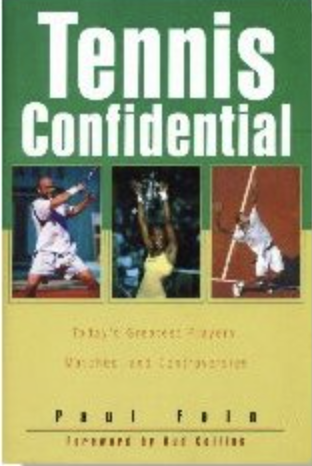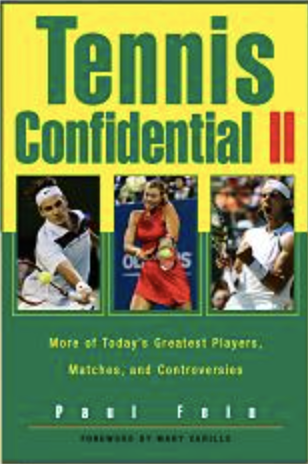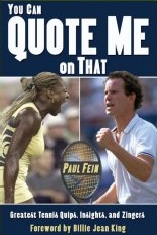You Can Learn a Lot from Watching the Pros
Hits: 48
“In no other sport are the strategic possibilities so numerous, the ways to outwit your opponent so rich and varied within the accepted sportsmanlike bounds.”
– Sarah Palfrey, a clever strategist who captured 18 Grand Slam titles in singles, doubles, and mixed doubles from 1930 to 1945. From her 1968 book, Tennis for Anyone!Sixty years ago, FCC Chairman Newton N. Minow, in a famous speech to a conference of broadcasters, called television “a vast wasteland.” That’s certainly not true of tennis on TV.I find watching the December re-runs of big 2021 matches on Tennis Channel interesting, enjoyable, and instructive. For example, No. 1 Ash Barty’s 6-3, 6-7 (4), 6-3 victory over Karolina Pliskova in the Wimbledon final treated tennis fans to a clash between players with contrasting playing styles, physiques, levels of athleticism, and mental games. The most revealing part of the match, to me, came in the tiebreaker. The pressure of trying to win her first Wimbledon unnerved Barty, who is normally an excellent “big points” and “big games” player. After making unforced backhand errors and hitting weak backhands, she fell behind 6-4 and then double-faulted to lose the tiebreaker. The Fein Points of Tennis has a chapter about how to close out close matches.Pliskova knew the stakes were super-high for her, too. All too often during her underachieving career, the 29-year-old Czech undermined her chances with a fatalistic attitude and lack of competitiveness. Not in this crucial tiebreaker, though. She showed great positivity, fist-pumping, and sprinted for distant balls as if her legacy depended on it. She also demonstrated her fighting spirit by coming back from a service break down at 6-3, 3-1 earlier in the second set.Barty boasts so much athletic and racket ability plus the tactical acumen to maximize these abilities that she can win points in a variety of ways. That can frustrate and foil players like 6’1” Pliskova, who lack running speed and great defensive skills. The 5’5” Barty’s only weak link is her backhand—the two-handed version is inconsistent and the one-handed slice sometimes floats. But that weak link is sometimes a big one.For much of the final, Pliskova didn’t capitalize enough on this Barty weakness. Groundstroke weaknesses are most revealed on passing shots, service returns, and long rallies. Pliskova should have come to net much more to force Barty to hit backhand passing shots more often. She also should have capitalized on Barty’s relatively weak backhand slice service returns by attacking them more aggressively than she did.Barty has the stronger mental game, and she shrugged off her poor tiebreaker and regrouped beautifully in the deciding set. Her backhand held up, and she smacked serves and forehands very effectively.How can someone only 5’5” tall generate first serves in the 106 to 112 mph range? To learn more, check out the chapter in my book about the serve.And be sure to read the chapter titled “What You Can Learn from Watching the Pros.” You can learn a lot!
The most revealing part of the match, to me, came in the tiebreaker. The pressure of trying to win her first Wimbledon unnerved Barty, who is normally an excellent “big points” and “big games” player. After making unforced backhand errors and hitting weak backhands, she fell behind 6-4 and then double-faulted to lose the tiebreaker. The Fein Points of Tennis has a chapter about how to close out close matches.Pliskova knew the stakes were super-high for her, too. All too often during her underachieving career, the 29-year-old Czech undermined her chances with a fatalistic attitude and lack of competitiveness. Not in this crucial tiebreaker, though. She showed great positivity, fist-pumping, and sprinted for distant balls as if her legacy depended on it. She also demonstrated her fighting spirit by coming back from a service break down at 6-3, 3-1 earlier in the second set.Barty boasts so much athletic and racket ability plus the tactical acumen to maximize these abilities that she can win points in a variety of ways. That can frustrate and foil players like 6’1” Pliskova, who lack running speed and great defensive skills. The 5’5” Barty’s only weak link is her backhand—the two-handed version is inconsistent and the one-handed slice sometimes floats. But that weak link is sometimes a big one.For much of the final, Pliskova didn’t capitalize enough on this Barty weakness. Groundstroke weaknesses are most revealed on passing shots, service returns, and long rallies. Pliskova should have come to net much more to force Barty to hit backhand passing shots more often. She also should have capitalized on Barty’s relatively weak backhand slice service returns by attacking them more aggressively than she did.Barty has the stronger mental game, and she shrugged off her poor tiebreaker and regrouped beautifully in the deciding set. Her backhand held up, and she smacked serves and forehands very effectively.How can someone only 5’5” tall generate first serves in the 106 to 112 mph range? To learn more, check out the chapter in my book about the serve.And be sure to read the chapter titled “What You Can Learn from Watching the Pros.” You can learn a lot!



